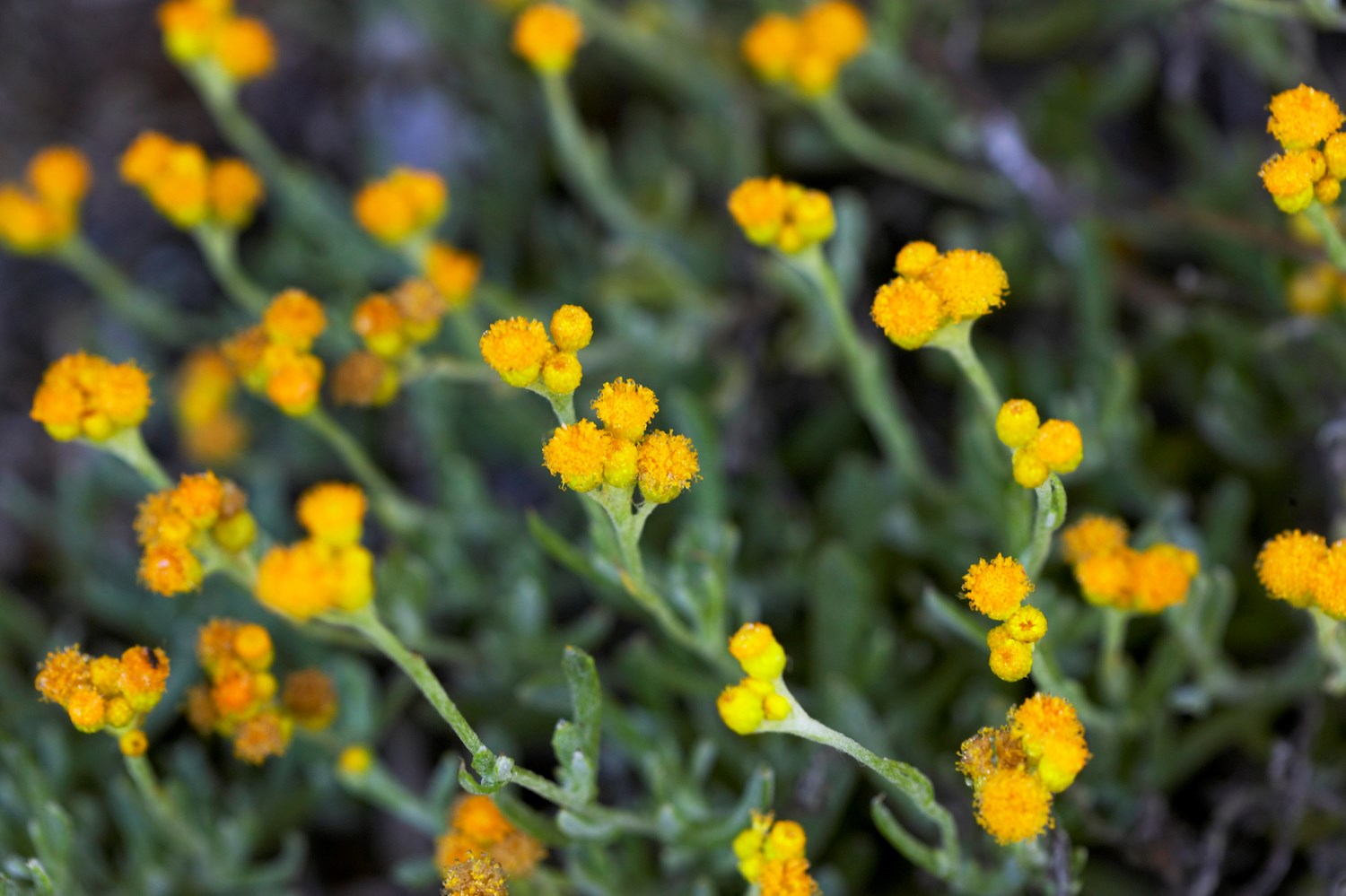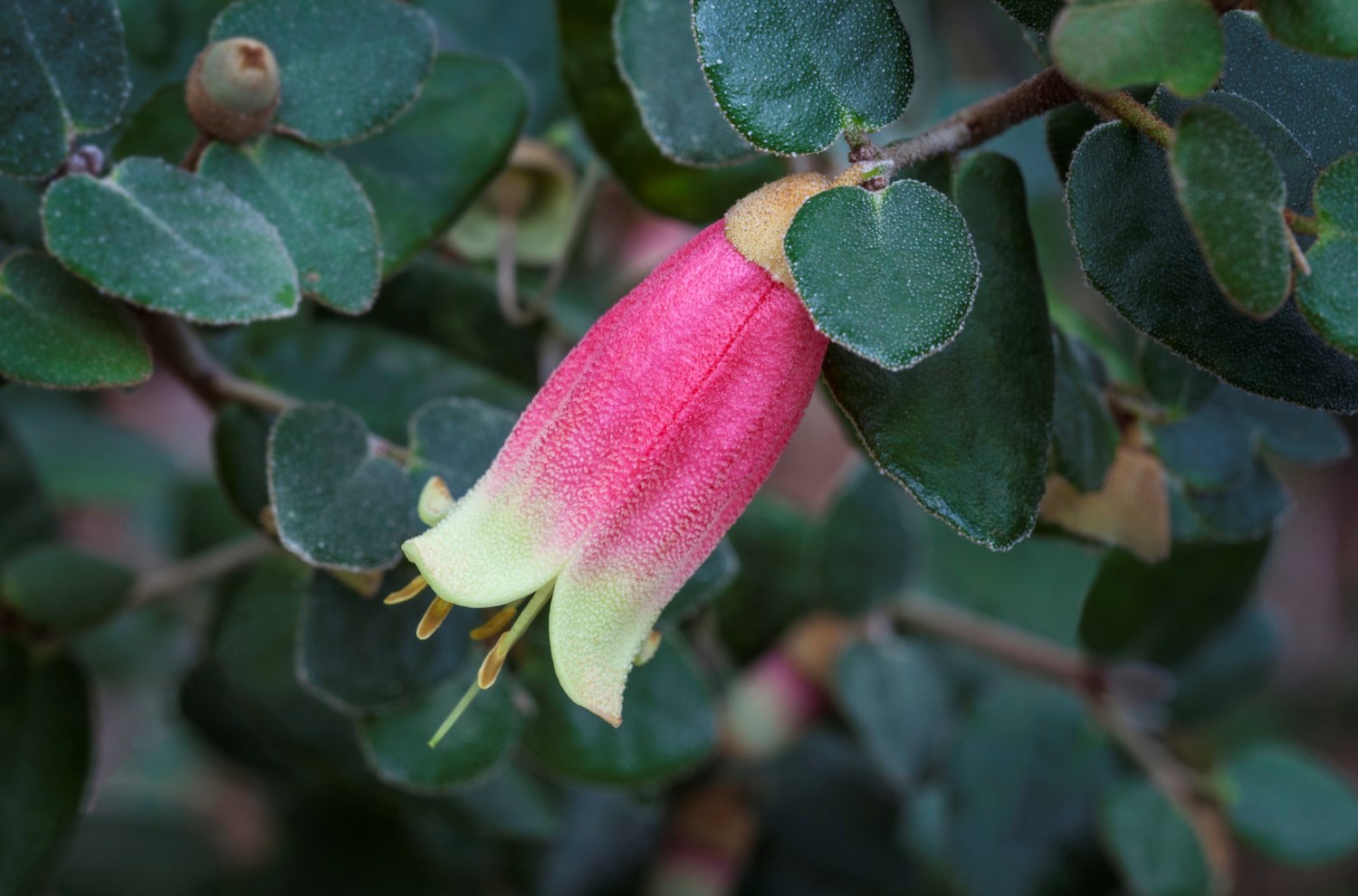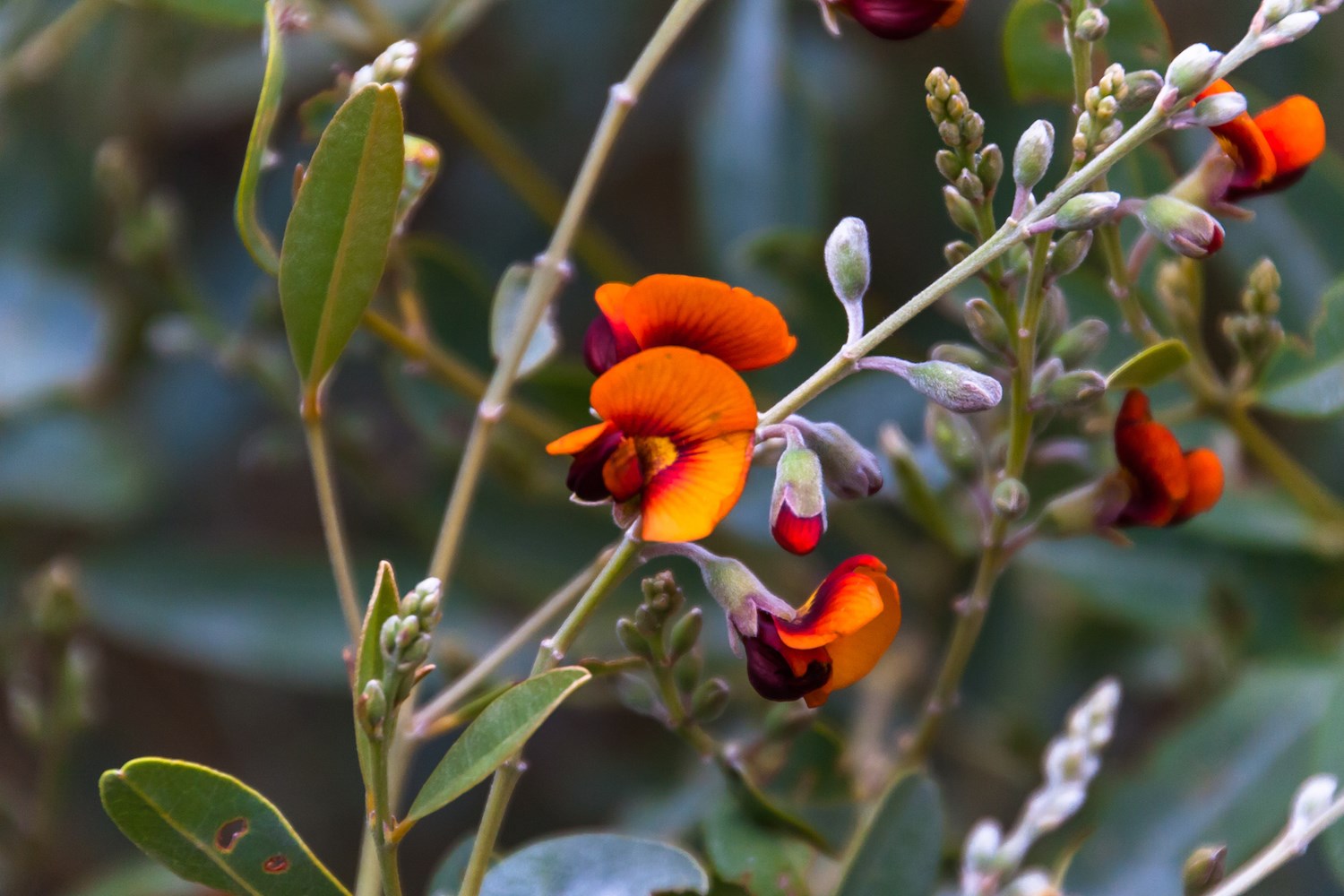1. Desert Flame Chrysocephalum apiculatum
Desert Flame is a perennial Australian native that brings a blaze of colour to the garden with golden yellow flowers and silvery grey foliage. It's a hardy, maintenance plant that provides stunning ground cover and can grow 20–30cm tall. It prefers temperate climates and grows best in full sun or part shade and most soil types.
2. Grevillea
Grown all over Australia, grevilleas are fuss-free, native shrubs that flower profusely! They come in a great range of sizes, from ground covers and mid-sized shrubs to tall screening plants, which are perfect for privacy. Their year-round flowers are also simply irresistible to native birds and insects. These beauties need well-drained soils and are sun lovers, so plant in full sun and keep sheltered from strong winds.
3. Kangaroo paw Anigozanthos
Absolutely stunning when in bloom, evergreen when not, the popular native kangaroo paw is an ideal low-maintenance but high-impact plant. And fun fact – the Anigozanthos is the state flower of Western Australia. All species have strap-like leaves and tubular flowers, you can find them in single, bi-coloured and even tri-coloured forms, in red, yellow, green, orange, pink and near-white. Kangaroo paws do best in slightly acidic soils with good drainage and full sun exposure.
4. Canberra Bells Correa
Correa ‘Canberra Bells’ produces a mass of red and cream bell-shaped flowers throughout autumn on a compact shrub to 1m. Frost and drought hardy, correas are sometimes referred to as native fuchsias and are one of the most reliable native shrubs for autumn colour. This one is great in a mixed garden bed or as a low growing hedge; prune lightly after flowering to maintain a neat compact shape. It grows well in almost any soil, in shade or full sun, but prefers a light sandy soil with good drainage and a position protected from wind.
5. Pink rock lily Dendrobium
The Australian native Dendrobium kingianum, or pink rock lily, is tough and easy to grow, producing delicate flowers from pure white through to pink and purple. On the other end of the spectrum is the striking Cooktown orchid with round, long-lasting flowers. And there are many more in this huge genus. All dendrobiums like light but need shelter from intense midday sun. Tropical species require warmer conditions and more humidity than temperates. During the hotter months, a weekly feed of one-quarter strength fertiliser will ensure robust healthy growth, but as the weather starts to cool, ease off the watering and fertiliser. Australian native dendrobiums will thrive on rock faces or attached to tree branches in filtered light.
6. Aussie Box Westringia
Westringia ‘Aussie Box’, a new form of the popular shrub, makes a lovely low hedge. Growing to about 60 x 60cm, it’s drought-hardy and produces tiny mauve flowers on and off throughout the year. It prefers full sun to light shade, suits most soil types and tolerates frost and drought.
7. Lilly pilly Syzygium smithii
Lilly pilly – also known as an Australian cherry – is an evergreen tree that has glossy leaves and fragrant white flowers in summer before producing edible red or purple fruit. It's a popular hedge option as it quite dense and can be trimmed and ‘topiaried’ to your heart’s content. Lilly pillies prefer fertile, well-draining soil.
8. Bottlebrushes Callistemon
The bottlebrushes gets its name from the vibrant, red flower arrangements it produces, which closely resembles a bottle cleaning brush. Tree shapes and sizes vary considerably, so there’s one suitable for just about any garden. Bottlebrushes are a hardy, low-maintenance plant, which can do well (and even thrive) in damp conditions. Bursting into bloom from early spring, bottlebrush delivers rich pickings for birds.
9. Silver spurflower Plectranthus argentatus
The leaves and branches of this loose-spreading shrub are covered with short silver hairs, which create a fabulous shimmery gleam in the garden. Native to Australia, it’s one of the best silver-leaved plants to use in shady areas.
10. Australian honeysuckles Banksia
Loved for their flower spikes in gold, red and orange, banksias flower profusely and for an extended period. They come in various forms, from medium-sized shrubs to spreading groundcovers, and make eye-catching arrangements for events like parties, weddings and funerals. A favourite, ‘Giant Candles’ produces large flower spikes on a 4m tall shrub. For lower growing options, check out dwarf varieties of banksia, such as ‘Cherry Candles’. It has a spreading habit of 1.5–2m – great for pots or in ground. Plant in well-draining soil or native potting mix and full sun. Feed with a controlled release
fertiliser formulated for natives.
11. Pink (common) heath Epacris impressa
A generous bloomer, common heath (Epacris impressa) flowers almost year-round, but is most profuse in winter. Flower colour varies from white to pink to deep crimson. It grows up to 1m tall and wide, but commonly remains a 50cm shrub in gardens. Plant in well-drained sandy soil and full sun or part shade. Prune after flowering to maintain its bushy shape.
12. Chorizema
Chorizema has orange, pink and red flowers in winter and early spring. So versatile, let it sprawl across
garden beds, use as a groundcover or support it to grow as a climber. It grows 1–1.5m high and wide, but you can contain it with a light trim. Plant in moist, well‐drained soil and dappled light. Cut back hard after flowering to maintain a tidy form.
13. Waxflower Crowea exalata
With star-shaped flowers in white or pink, croweas are available as low-growing groundcovers or compact shrubs. Growing 20cm–1.5m high and spreading 75cm – 1.5m, they make great border plants. Look for large-flowering Crowea exalata ‘Southern Stars’. It has dainty blooms and purple stems. Plant in well-drained soil in partial sun. Lightly prune when flowering finishes.
14. Wattles Acacia
The Golden Wattle (Acacia pycnantha) variety is the national flower of Australia. Wattles live life in the fast lane, growing rapidly from seed and producing stunning yellow flowers from a young age. Wattles grow happily in any sunny to semi-shaded spot. They have good tolerance to extremes of both heat and cold, however, if your garden is prone to heavy winter frosts, it’s worth planting species indigenous to your area, as these will be the most robust growers. Wattles aren’t fussy about soil types but do need it to be free draining, so don’t plant in soggy spots that are slow to drain after heavy rainfall.
15. Waratah Telopea speciosissima
The waratah is arguably the most beautiful and instantly recognisable of our native wildflowers. The bold, usually blood-red flower heads are held above striking foliage, shining like beacons in the bush during spring. The type that most people know is Telopea speciosissima, the New South Wales waratah, and its hybrid forms. Part sun is best as only a few waratahs tolerate full or afternoon sun. Protect from wind. Waratahs thrive in free-draining, preferably slightly acid soil, with material such as a leaf compost blended in. Don't plant into clay soil as they won't tolerate wet feet.
16. Sturt's Desert Pea Swainsona formosa
Sturt's desert pea is the floral emblem for South Australia, famous for its eye-catching blood-red petals, each with a black pea-like centre. They can be difficult to grow at home and full sun and perfect drainage is essential for success.
You might also like:
This native Australian plant is the affordable solution to a fresh cut flower bouquet
Six flowering trees for a big impact
Why not arrange your native flowers into beautiful bouquets? watch our flower arranging tips below!
















